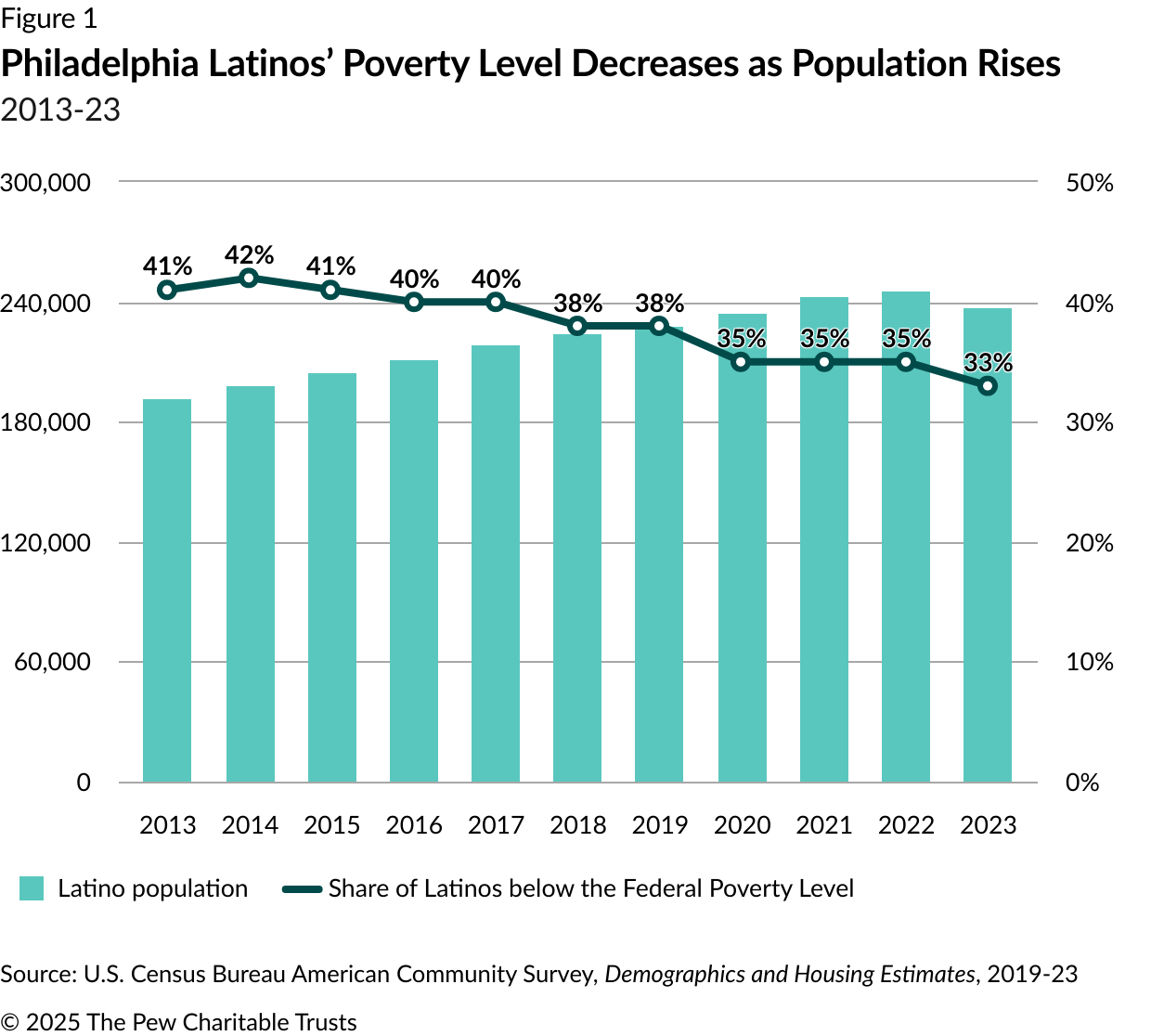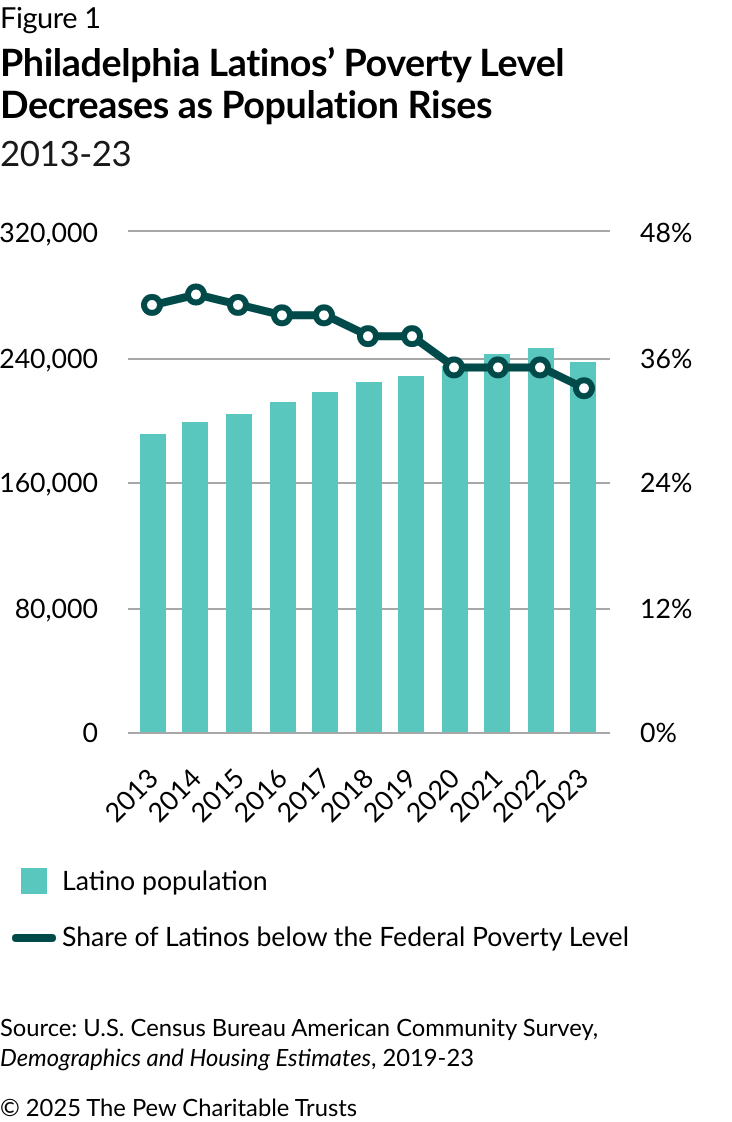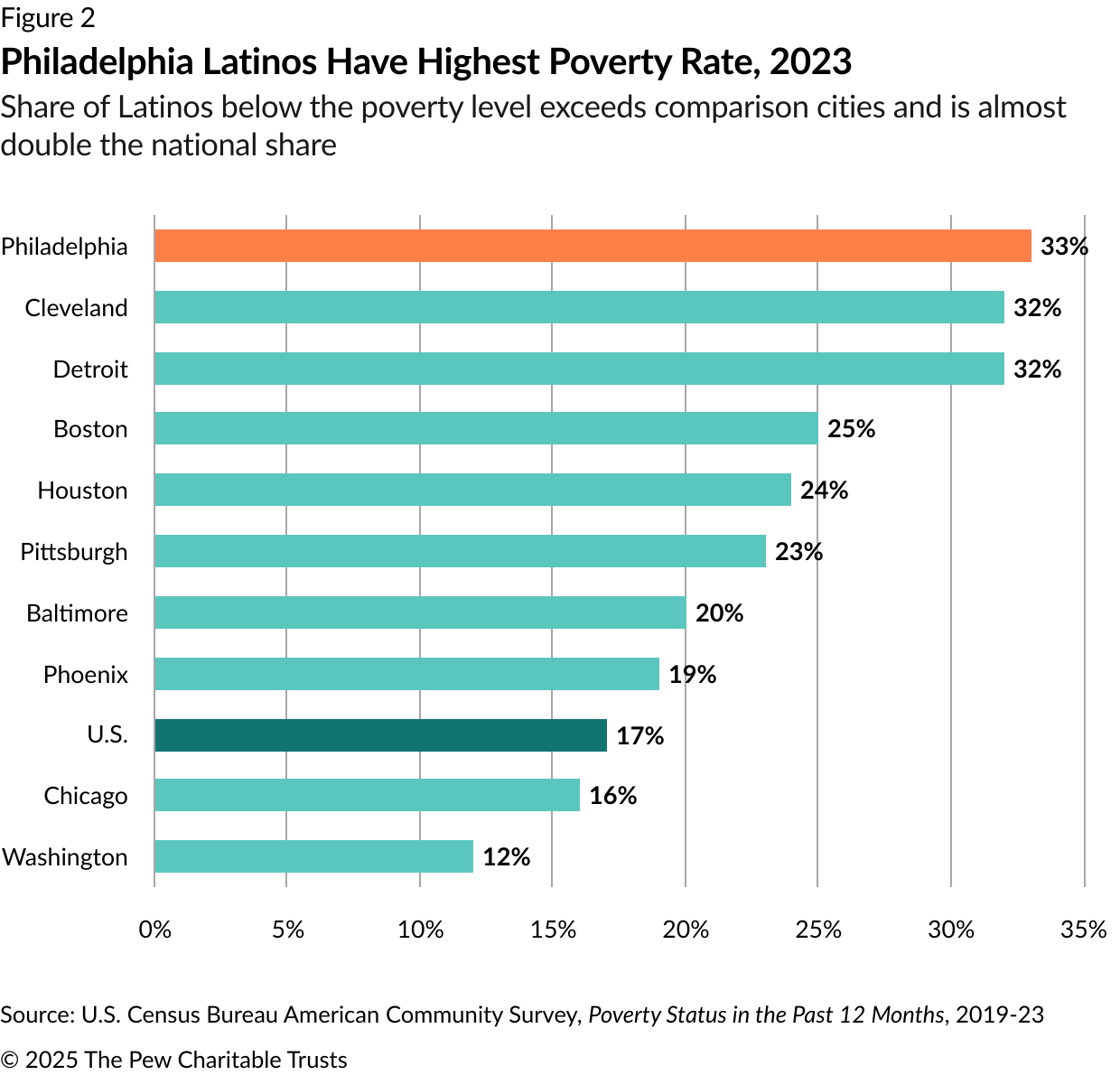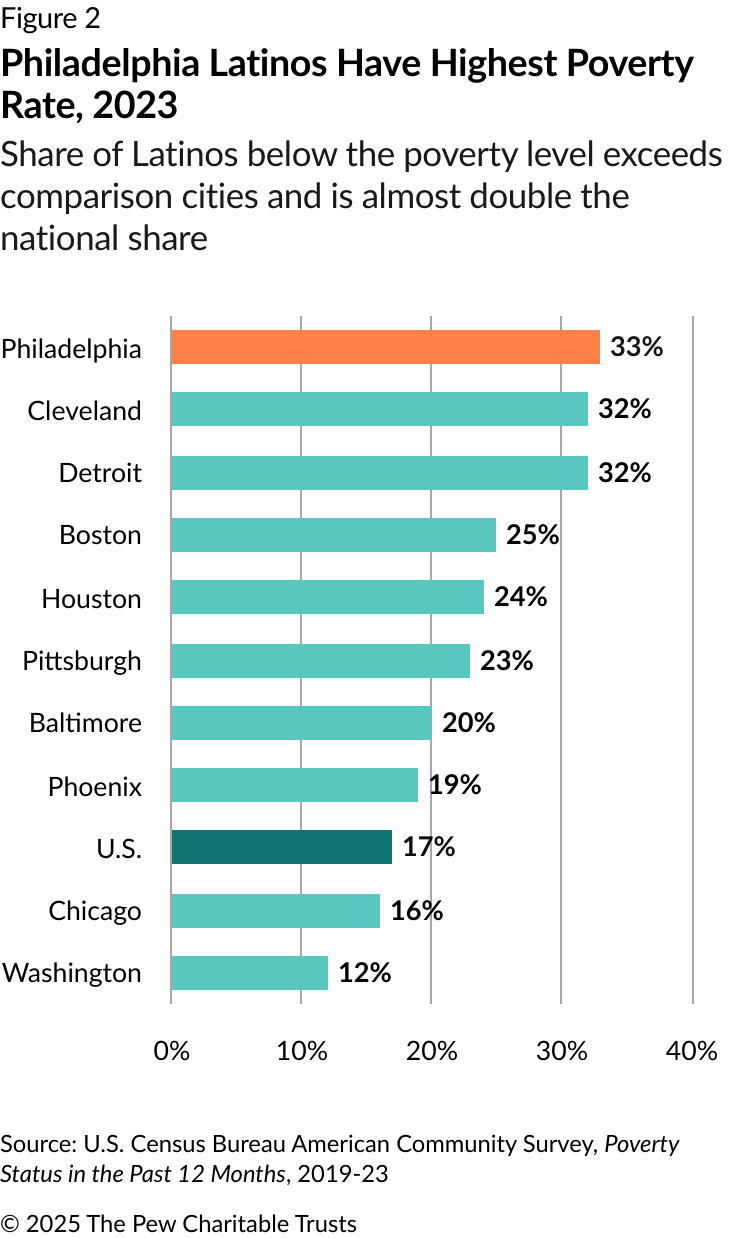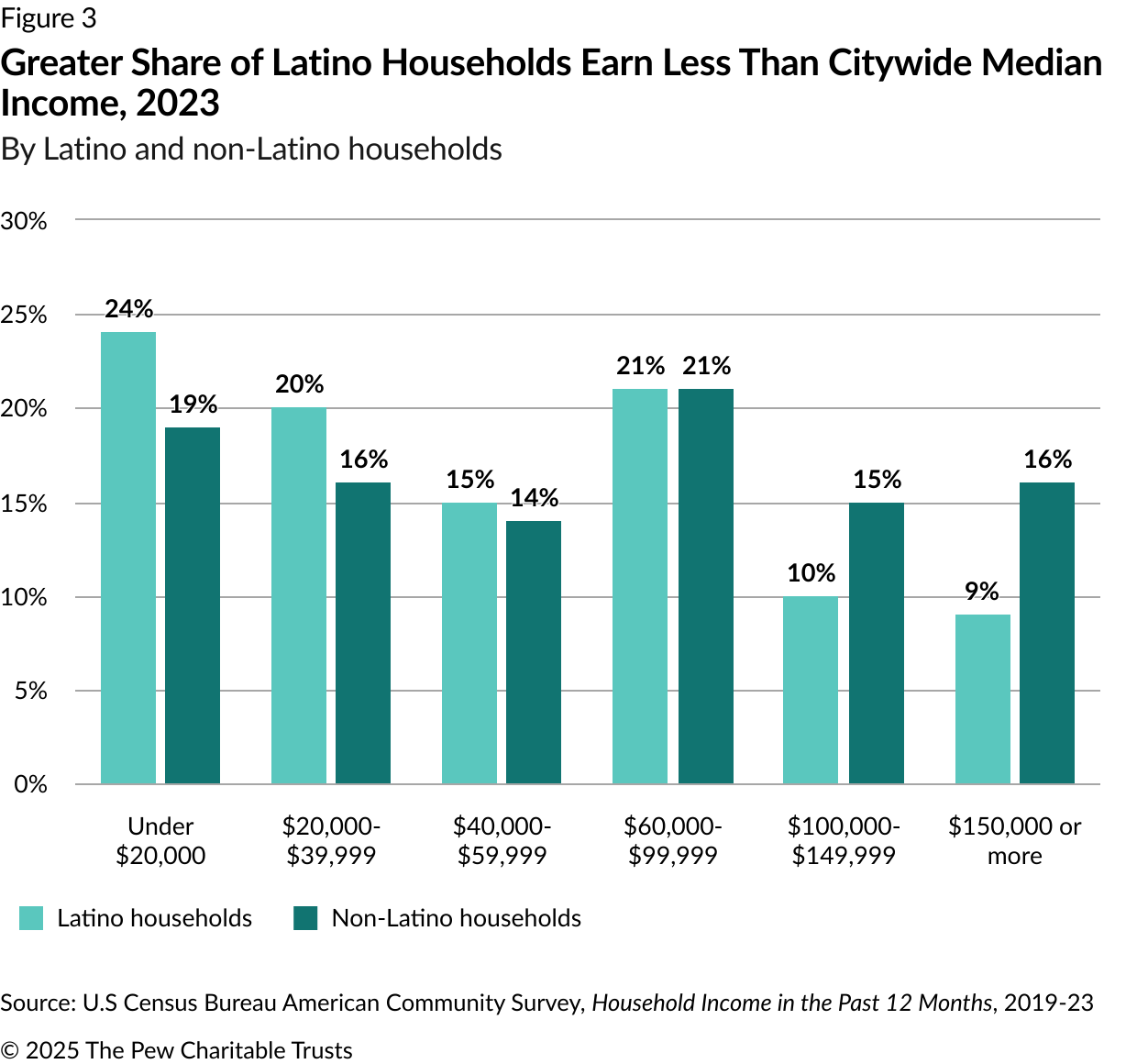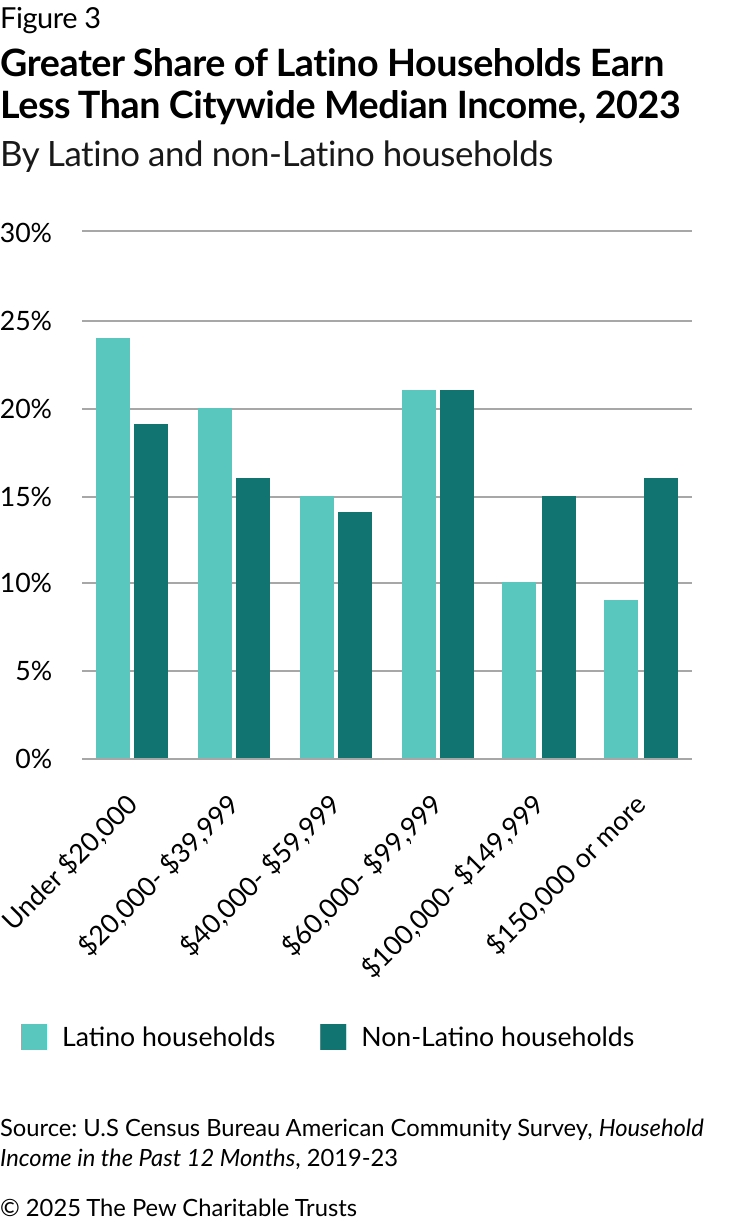In Philadelphia, Declining Poverty Rate Among Latinos Offers an Incomplete Picture
A higher share of Latinos earning over $150,000 has brought that rate down, but many still live below the federal poverty level
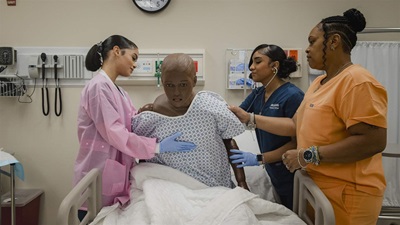
Editor's note: On Sept. 26, 2025, the median income of Latino-led households was updated to clarify that it included only households below the poverty level.
Overview
Philadelphia has seen a steady decline in the poverty rate in the last decade.1 In 2013, 27% of residents (396,000 Philadelphians) lived in poverty—that rate declined to 22% in 2023 (339,000 Philadelphians). Despite this citywide decrease, the poverty rate among Philadelphians who identify as Latino remains the highest among the city’s racial and ethnic groups—a trend that’s held for over a decade.
Though the poverty rate among Philadelphia Latinos decreased by about 8 percentage points from 2013 to 2023 (from 41% to 33%), the number of Latinos living below the federal poverty line increased slightly, by nearly 500 residents. These contradictory trends may be driven by higher-income Latinos moving into Philadelphia. While many live below the poverty level, there has been an increase in the number of Latinos earning over $150,000 annually.
Despite facing persistent high levels of poverty, Latinos are the fastest-growing demographic group in the city. The share of Latinos living in Philadelphia has tripled since the 1990s: An estimated 240,000 residents identify as Latino, and they make up about 15% of the city’s population. At the same time, the Latino population has also become increasingly diverse.2 Historically, Latinos born in Puerto Rico or with Puerto Rican heritage represented the largest proportion of Latino residents in the city, but their share of the population has decreased since 2010—though the number of Puerto Rican residents has stayed relatively the same, at an estimated 133,000 residents. So, while Puerto Ricans still make up the largest percentage of Philadelphia Latinos (55%), there has been an increase in both non-Puerto Rican U.S.-born and foreign-born Latinos. As of 2023, around 34% of U.S.-born Philadelphia Latinos are descendants of people from other parts of Latin America, and about 19% of Latinos in Philadelphia are foreign-born.
In Philadelphia, foreign-born residents do not have a significantly higher poverty rate than the U.S.-born population, and thus this was not explored further as a reason why Latinos face such high shares of the population living below the poverty level.3 Rather, research from KFF—an independent source for health policy research, polling, and news—has found that, nationally, individuals with limited English proficiency are more likely to live below the poverty line and earn lower wages.4 Although Puerto Rican residents, like other Latinos, may have limited English proficiency, and though residents born on the island of Puerto Rico often have an immigrant-like experience, all Latino residents—including Puerto Ricans—are equally likely to live below the poverty level in Philadelphia. For those reasons, this analysis examined the Latino population as a whole.
Through an analysis of the U.S. Census Bureau’s American Community Survey data and IPUMS microdata, as well as conversations with community leaders and other stakeholders, The Pew Charitable Trusts found that language proficiency, neighborhood investment, and the state’s minimum wage were all themes related to the high share of poverty among Latinos. During interviews for this project, a small group of participants told Pew that coming from households with limited English proficiency affected their own economic mobility and hindered their ability to escape multigenerational poverty.
Not only is the percentage of Latinos living below the poverty level the highest among demographic groups in the city, but Philadelphia is also uniquely positioned compared with other cities. Across the city’s three largest other demographic groups—non-Hispanic White, non-Hispanic Black, and Asian—it was only in Philadelphia that Latinos had the highest share of those living below the federal poverty level.5
Of the Philadelphia Latinos living below the poverty level, about 41% are children, compared with the citywide figure of 30%. Poverty among Latinos is also significantly higher among single female heads of household, who make up 64% of the households living below the poverty level, compared with only 9% of those led by single male heads of household.
“Philly is in my DNA,” said Tabatha Reyes, a single mother and participant in the nonprofit Xiente’s economic development programs. “In Philly, we are just staying afloat and not thriving. For years, minimum wage and government programs stay the same; meanwhile, expenses go up every year.”
An individual earning minimum wage in Philadelphia, set at $7.25, is expected to earn an estimated $15,000 annually. Among the comparison cities, Baltimore, Chicago, Cleveland, Detroit, Phoenix, and Washington have a minimum wage that exceeds the federal rate of $7.25 an hour.6
In 2025, for a family of four to be considered living at or below the poverty level, the annual household income must be at or below $32,150, according to the U.S. Department of Health and Human Services.7 But this does not take into consideration the cost of living in the area where the household members live.
The United For ALICE wage tool—a resource created by United Way that estimates how many households are income constrained—found that a household with two adults and two children in child care in Philadelphia requires at least $96,276 to cover housing, food, transportation, and other basic needs.8 The median household income of Latino-led households below the poverty level in Philadelphia is $14,490.
Approximately 75% of Latino adults ages 20-64 are in the labor force, aligned with the citywide figure of 76% labor force participation for residents in the same age group. This highlights that the high poverty rate among Latinos is not connected to the population’s participation in the workforce but is perhaps more connected to lower wages.
In the last decade, the median income for Latino households has increased by 40%, while the citywide median income has increased by 26%. Although 59% of Latino households earn below the citywide median of roughly $60,000, since 2013, there’s been approximately an eightfold increase in the number of Latino households that earn more than $150,000 annually.
In Philadelphia, the greatest concentrations of Latinos live in areas with the highest share of residents living below the poverty level.
The connection between these two facts is not a coincidence, as a city official elaborates: “The historic disinvestment in key neighborhoods has left many in the Latino community grappling with extreme economic stress,” said William Garcia, director of the Mayor’s Office of Latino Engagement.
Through setting universal goals and deploying targeted strategies, such as focusing on areas where poverty has persisted, government officials and other stakeholders may be able to see a change in the city’s long-standing issue.
Garcia highlighted some policy solutions that could help: “The state needs to raise the minimum wage and the city needs to streamline processes, as it did for the 30,000 Homes Initiative, and make government more accessible, like the creation of mini-City Hall in Fairhill.”
The high share of Latinos living below the poverty level in Philadelphia is connected to historical and economic trends and opportunities available in the city. Considering the population’s diverse backgrounds, and with Latinos often having a distinct language and disproportionate representation in blue-collar jobs, they face poverty at higher rates, especially among children and single female-led households.9 Although Latinos are not less likely to participate in the labor force or be employed, they are more likely to have lower household earnings.
“If a community is not thriving, then the individual will not be able to thrive emotionally, financially, or mentally,” Reyes said.
According to the U.S. Census Bureau, across all geographic areas, the Latino population has a statistically significant undercount in the decennial census and the American Community Survey—the primary and most readily available source of data for this analysis.10 This means that the estimates in this report are likely to be an undercount. Stubborn poverty rates among Latinos in Philadelphia remain a challenge for policymakers as they look to enact programs to reduce poverty rates citywide and within this community.
Endnotes
- “Philadelphia Is ‘America’s Poorest Big City.’ Here’s What That Actually Means,” Kenny Cooper, WHYY, Jan. 10, 2024, https://whyy.org/articles/philadelphia-americas-poorest-big-city-poverty/.
- The Pew Charitable Trusts, “Philadelphia's Immigrants: Race and Ethnicity,” 2024, https://www.pew.org/en/research-and-analysis/fact-sheets/2024/06/philadelphias-immigrants-race-and-ethnicity.
- “U.S. Hispanic Population Living in Poverty, 2021,” Pew Research Center, Aug. 16, 2023, https://www.pewresearch.org/chart/us-hispanics-poverty/.
- “Overview of Health Coverage and Care for Individuals With Limited English Proficiency (LEP),” Sweta Haldar, Drishti Pillai, and Samantha Artiga, KFF, July 7, 2023, https://www.kff.org/racial-equity-and-health-policy/issue-brief/overview-of-health-coverage-and-care-for-individuals-with-limited-english-proficiency/.
- “The State of 10 Cities,” The Pew Charitable Trusts, June 6, 2023, https://www.pew.org/en/research-and-analysis/data-visualizations/2019/the-state-of-10-cities.
- “State Minimum Wage Laws,” U.S. Department of Labor, https://www.dol.gov/agencies/whd/minimum-wage/state.
- “2025 Poverty Guidelines: 48 Contiguous States,” U.S. Department of Health and Human Services, https://aspe.hhs.gov/sites/default/files/documents/dd73d4f00d8a819d10b2fdb70d254f7b/detailed-guidelines-2025.pdf.
- “The State of Alice in Pennyslvania,” United Way, https://www.unitedforalice.org/county-reports/Pennsylvania#11/40.0027/-75.1180.
- “Poverty Among Hispanic Children in the U.S.,” Lisa A. Gennetian and Yiyu Chen, ECONOFACT, Feb. 21, 2024, https://econofact.org/poverty-among-hispanic-children-in-the-u-s.
- U.S. Census Bureau, “Census Bureau Releases Estimates of Undercount and Overcount in the 2020 Census,” news release, March 10, 2022, https://www.census.gov/newsroom/press-releases/2022/2020-census-estimates-of-undercount-and-overcount.html.

